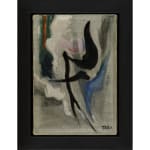Okamoto Tarō (1911–1996)
Work
Oil on canvas, framed
23 x 16 cm
29 x 22 cm (overall)
Anyone can write characters. They are meant to be written. If it amounts to calligraphy or not
is irrelevant. You have to draw the lines without hesitation, let it hit you unconditionally. Brush
and ink means unlimited color. Your whole being will open up on the paper, and dreams will
come to life. These characters are there to play with. The pleasure of being alive comes out
of this. It is truly an art form.
The above is a quote from Okamoto Taro’s publication Asobu ji (characters at play, 1981). Here, the artist explores the idea of characters (kanji, kana, letters…) that are not written to be read but to be seen. The works he made are based on a character but mixed and extended with red and blue lines as if to create new, fantastic characters. Lines flowing in and out of the character’s shape build a new form. Some lines become dots. But it is difficult to say what character they represent.
In the 1960s, prior to Asobu ji, Okamoto produced character-like works that were more similar to paintings. The present Work belongs to that group, but the character-pictures of 1960 have a different meaning than the ones in Asobu ji. Probably even before painting characters “to be read,” Okamoto had experimented with works that show abbreviated, or rather “pictorialized,” sign-like characters. To the artist’s eyes in those days, the external shape of a character and a real landscape perhaps looked all the same.
Work resembles the cypher-like wall image at the entrance of the Okamoto Taro Memorial Museum in Aoyama (Tokyo), which may be described as a semi-abstract representation of a human face. If one was to add eyes left and right of the line in the center what appears as a “character” quickly turns into a face like the one of the museum’s entrance. We don’t know which characters Okamoto has based Work on, but as he once said, “On white paper, black lines are running… vividly, they represent the stage of human life. The pleasures that sho (calligraphy) provides are different from painting, that’s why I wield my brush often.” (The Works of Taro Okamoto)
Okamoto Taro (painter, sculptor; 1911–1996)
Painter and sculptor, born in Kanagawa Prefecture. Okamotos’s father was the manga artist Okamoto Ippei, his mother was the poet and novelist Okamoto Kanoko. Okamoto graduated from the University of Paris. While in Paris, he joined the abstract and surrealist movements; after the war, he exhibited at the Nikakai, gradually expanding his activities to include painting, sculpture, art criticism, and TV appearances. He is well-known for the Tower of the Sun, made for the Expo ’70 at Osaka.
is irrelevant. You have to draw the lines without hesitation, let it hit you unconditionally. Brush
and ink means unlimited color. Your whole being will open up on the paper, and dreams will
come to life. These characters are there to play with. The pleasure of being alive comes out
of this. It is truly an art form.
The above is a quote from Okamoto Taro’s publication Asobu ji (characters at play, 1981). Here, the artist explores the idea of characters (kanji, kana, letters…) that are not written to be read but to be seen. The works he made are based on a character but mixed and extended with red and blue lines as if to create new, fantastic characters. Lines flowing in and out of the character’s shape build a new form. Some lines become dots. But it is difficult to say what character they represent.
In the 1960s, prior to Asobu ji, Okamoto produced character-like works that were more similar to paintings. The present Work belongs to that group, but the character-pictures of 1960 have a different meaning than the ones in Asobu ji. Probably even before painting characters “to be read,” Okamoto had experimented with works that show abbreviated, or rather “pictorialized,” sign-like characters. To the artist’s eyes in those days, the external shape of a character and a real landscape perhaps looked all the same.
Work resembles the cypher-like wall image at the entrance of the Okamoto Taro Memorial Museum in Aoyama (Tokyo), which may be described as a semi-abstract representation of a human face. If one was to add eyes left and right of the line in the center what appears as a “character” quickly turns into a face like the one of the museum’s entrance. We don’t know which characters Okamoto has based Work on, but as he once said, “On white paper, black lines are running… vividly, they represent the stage of human life. The pleasures that sho (calligraphy) provides are different from painting, that’s why I wield my brush often.” (The Works of Taro Okamoto)
Okamoto Taro (painter, sculptor; 1911–1996)
Painter and sculptor, born in Kanagawa Prefecture. Okamotos’s father was the manga artist Okamoto Ippei, his mother was the poet and novelist Okamoto Kanoko. Okamoto graduated from the University of Paris. While in Paris, he joined the abstract and surrealist movements; after the war, he exhibited at the Nikakai, gradually expanding his activities to include painting, sculpture, art criticism, and TV appearances. He is well-known for the Tower of the Sun, made for the Expo ’70 at Osaka.



